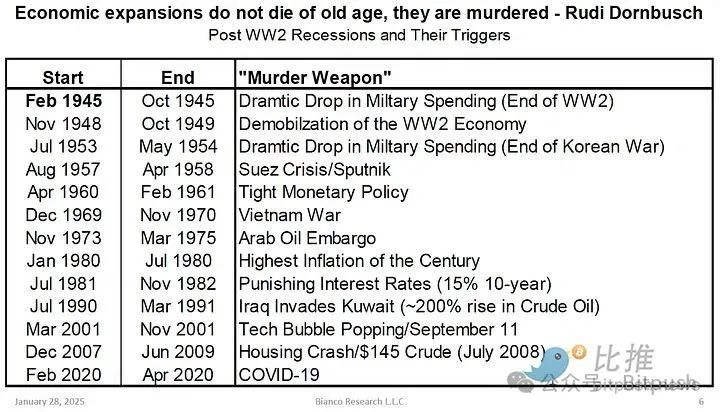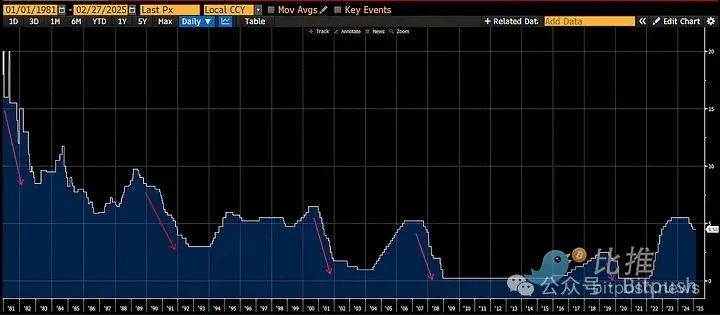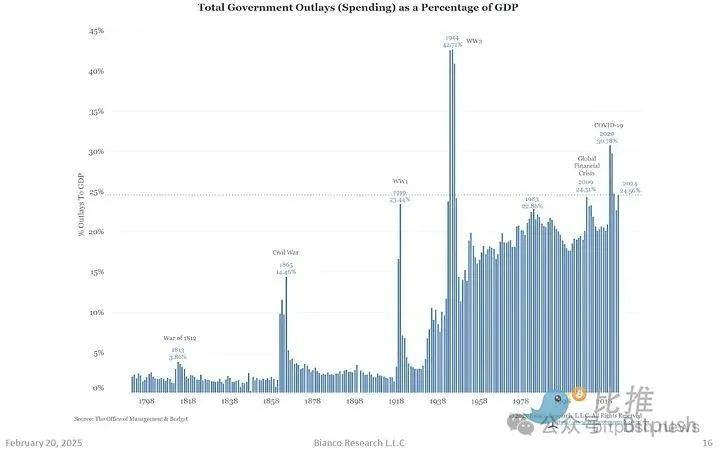Arthur Hayes latest blog post: Crypto market is still in a bull market, Trump's artificial recession will force the Fed to cut interest rates

Reprinted from panewslab
03/04/2025·2MAuthor: Arthur Hayes
Original title: KISS of Death
Compilation and organization: Compare BitpushNews

Keep — It — Simple — Stupid = KISS
Many readers tend to forget the KISS principles when dealing with the tide of policies of US President Donald Trump.
Trump’s media strategic goal is to make you wake up and say to your friend, partner or inner monologue every day: “My God, did you see what Trump/Musk/Jennedy Jr. did yesterday? I can’t believe they did it.” Whether you’re in high spirits or frustration, this farce called “The Emperor’s Day” is quite entertaining.
For investors, this continued state of excitement is not conducive to accumulating Bitcoin (sats). You might buy today and sell it quickly tomorrow after digesting the next headline. The market continues to fluctuate in this process, and your Bitcoin reserves shrink rapidly.
Remember the KISS principles.
Who is Trump? Trump is a real estate performance master. To be successful in the real estate sector, you must master the art of borrowing huge amounts of money at the lowest interest rate possible. Then, in order to sell the unit or rent the space, you have to brag about how impressive a new building or development will be. I’m not interested in Trump’s ability to elicit sympathy in a global society, but I’m interested in his ability to finance policy goals.
I am sure Trump hopes to achieve his “America First” policy through debt financing. If this is not the case, he would allow the market to naturally clear the credit embedded in the system and usher in a greater depression than the 1930s. Does Trump want to be called Herbert Hoover of the 21st century, or Franklin Delano Roosevelt (FDR)? American history devalues Hoover because historians believe that he does not print money quickly enough and praises Roosevelt because his New Deal policy is paid by printing money. I believe Trump wants to be considered the greatest president in history, and therefore, he does not want to destroy the foundations of the empire through austerity policies.
To emphasize this, remember that Hoover's U.S. Treasury Secretary Andrew Mellon said the following when talking about how to deal with the over-leveraged U.S. and global economy after the stock market crash:
"Liquidate labor, liquidate stocks, liquidate farmers, liquidate real estate. This will clear away corruption in the system. The high cost of living and luxury lifestyle will decline. People will work harder and live a more ethical life. Values will be adjusted and enterprising people will pick up wrecks from those with less ability."
Scott Bessent, the current U.S. Treasury Secretary, would not speak wildly like that.
If my point is correct, that Trump will achieve "America First" through debt financing, how will this affect my future global risk asset market, especially cryptocurrencies?
To answer this question, I have to form a perspective on the possible ways Trump may increase the amount of money/credit (i.e. printing money) and lower its price (i.e. interest rates). So I have to have an idea of how the relationship between the U.S. Treasury led by Scott Becent and the Federal Reserve led by Jerome Powell will evolve.
KISS Principles

Who are Becente and Powell serving? Is it the same person?
Besent was appointed by Trump 2.0. Judging from his past and present interviews, he strongly agrees with the "emperor"'s worldview.
Powell was appointed by Trump 1.0, but he was a capricious traitor who turned against Obama and Clinton. Powell destroyed his only little credibility when he cut interest rates by 0.5% in September 2024. At that time, the growth of the US economy was above the trend level and there was still sign of inflation, so there was no need to cut interest rates at all. But Obama Clinton's puppet Kamala Harris needs a boost, and Powell dutifully cut interest rates. The results didn't work as expected, but after Trump's victory, Powell announced that he would complete his term and once again firmly fought inflation.
Several things happen when you are carrying huge debts.
First, interest payments will consume most of your free cash flow. Second, you can’t raise funds for additional assets because given the high debt levels, no one will lend you money. So you have to restructure your debt, which requires extending maturity date and lowering coupon rates. This is a form of soft default, because doing so mathematically reduces the present value of the debt burden. Once your effective debt burden is reduced, you can borrow again at an affordable price. Looking at this issue from these perspectives, both the Treasury and the Federal Reserve play a role in restoring U.S. financial health. But the success of this effort was hampered by Becente and Powell serving different owners.
Debt restructuring
Becente publicly stated that the current debt structure of the United States must change. He hopes to eventually extend the average maturity of the debt burden, which is known on Wall Street as "debt maturity extension." Various macroeconomic experts have made suggestions on how to achieve this goal; I have discussed such solutions in detail in The Genie article. However, the most important thing for investors is that the United States will soft default on its debt burden by reducing its net present value.
Given the global distribution of U.S. debt holders, it will take time to achieve such a restructuring. This is a geopolitical "Goldi's Knot". So in the short term, that is, in the next three to six months, this has nothing to do with our cryptocurrency inventors.
New loan
Powell and the Fed have extensive control over the amount of credit and its price. The law allows the Federal Reserve to print money and purchase debt securities, thereby increasing the amount of money/credit, that is, printing money. The Fed also sets short-term interest rates. Given that the United States cannot default in the nominal US dollar, the Federal Reserve has decided on the risk-free interest rate of the US dollar, namely the effective federal funds rate (EFFR).
The Fed has four main leverages to manipulate short-term interest rates: the reverse repurchase plan (RRP), the reserve balance rate (IORB), the lower limit of the federal funds rate and the upper limit of the federal funds rate. Without delving into the complex details of the money market, we just need to understand that the Fed can unilaterally increase the quantity of the US dollar and lower its price.
If Becente and Powell serve the same Leader, it will be very easy to analyze the future path of dollar liquidity and China, Japan and the EU's response to U.S. monetary policy. Given that they are obviously not serving the same person, I wonder how Trump can manipulate Powell to print money and lower interest rates while allowing Powell to stick to the Fed's task of fighting inflation.
Destroy the economy
Fed-Recession Law: If the U.S. economy falls into recession, or the Fed is worried that the U.S. economy will fall into recession, it will cut interest rates and/or print money.
Let's test this law with recent economic history (thanks to Bianco Research for this excellent form).

This is a list of direct causes of the modern American recession after World War II. The definition of recession is negative quarterly GDP growth. I will focus on the 1980s to the present.

Here is a chart of the lower limits of federal funds rate. Each red arrow represents the beginning of a loose cycle that occurs simultaneously with the recession. As you can see, it's very clear that the Fed will cut interest rates at least during the recession.
Fundamentally, “Pax Americana” and its global economy are financed on debt. Large companies fund future expansion and current operations through bond issuance. If cash flow growth slows down significantly or drops completely, the ultimate debt repayment will be questioned. This is problematic because the liabilities of a company are largely the assets of the bank. Bank-holding corporate debt assets support their client deposit liabilities. In short, if the debt cannot be repaid, it will question the “value” of all existing statutory credit bank notes.
In addition, in the United States, most households have added leverage. Their consumption patterns are marginally paid with mortgages, auto loans and personal loans. If their cash flow generation capacity slows or drops, they will be unable to meet their debt obligations. Similarly, the banking system holds these debts and supports its deposit liabilities.
Crucially, the Fed cannot allow massive defaults or an increase in the probability of corporate and/or household debt defaults during a recession or before cash flows slow or contract. This can lead to corporate and consumer debt defaults, resulting in systemic financial difficulties. To protect the solvency of the debt financing economic system, the Fed will actively or passively cut interest rates and print money whenever a recession occurs or when people's perception of the risk of recession increases.
KISS Principles
Trump manipulated Powell to relax the financial environment by triggering a recession or making the market believe that the recession is coming.
To avoid the financial crisis, Powell will then take some or all of the following measures: cut interest rates, end quantitative tightening (QT), restart quantitative easing (QE) and/or suspend the supplementary leverage ratio (SLR) of banks' purchase of U.S. Treasury bonds.
Here is a picture from DOGE:

How did Trump unilaterally trigger a recession?
The marginal driving force of U.S. economic growth has always been the government itself. Whether the expenditure is fraudulent or necessary, government spending creates economic activity. In addition, there is also a monetary multiplier effect in government spending. That's why the Washington, D.C. metropolitan area is one of the richest areas in the United States, because there are a lot of professional parasites sucking blood from the government. It is difficult to directly estimate the exact currency multiplier, but conceptually it is easy to understand that government spending has subsequent effects.
According to Perplexity data:
● The median household income in Washington, D.C. is $122,246, which is much higher than the national median household income.
● This makes Washington, D.C. ranked 96th percentile among U.S. household income cities.
As a former president, Trump is well aware of the extent of fraud, fraud and waste that exists within the administration. Neither establishment in both parties wants to curb this situation because everyone benefits from it. Given that Trumpists are people outside of the Democrats and Republicans, they do not hesitate to expose the drawbacks in government spending plans. The establishment of an advisory committee led by Elon Musk and supported by Trump, called the "District of Government Efficiency (DOGE)" is the core driving force for the rapid and significant reduction of government spending.
How does DOGE do this when many of the largest expenditure items are non-discretionary expenditures? If the payment is fraudulent, payment can be stopped. If computers can replace government employees who manage these projects, the cost of human resources will drop sharply. The question becomes, how much fraud and inefficient behavior is there in government spending every year? If DOGE and Trump say it is true, then the amount will reach trillions of dollars each year.
One example that may be very obvious is who the Social Security Administration (SSA) sends checks to. If we believe DOGE's claim, the department is paying nearly a trillion dollars to deceased persons and those whose identities have not been properly verified. I don't know the truth of this statement. But imagine you are an SSA welfare fraudster and knowing Elon and the Big One are delving into the data, you might find fraudulent payments you’ve received over the years and submit them to the Justice Department. Do you continue your scam or run away? The key is that the mere threats found can lead to a decrease in fraudulent activity. Just like the old Chinese saying, killing the chicken to scare the monkey. So, while the establishment media is fooling Elon and DOGE, I believe that if not one trillion dollars, there will be hundreds of billions of dollars.
Next, let’s talk about the human resources aspect of the government spending equation. Trump and DOGE are firing hundreds of thousands of government employees. Whether unions have enough power to pose legal challenges to the mass elimination of “useless” government workers remains to be determined. But the consequences have already emerged.
"The layoffs we've seen so far may be the tip of the iceberg. The scale and timing of future layoffs will determine whether the labor market can remain stable. We currently expect the number of federal government workers to be reduced by about 400,000 by 2025 due to ongoing recruitment freezes, delayed resignations and DOGE-initiated layoffs."
–Fox Business
Even if Trump’s 2.0 presidency has only just started a little over a month, the impact of DOGE is obvious. Unemployment benefits applicants surge in the Washington, D.C. area. House prices plummeted. Consumers' discretionary spending can be said to be driven by large-scale fraud and fraud by the U.S. government, which also disappoints financial analysts' predictions. The market started talking about the word “recession.”
House prices in Washington, D.C. have fallen 11% since the beginning of the year, tracking the impact of actions by the Department of Government Efficiency (DOGE) on the city's real estate market, a new analysis by real estate trading platform Parcl Labs shows.
–Newsweek
Rothstein posted on Bluesky that the U.S. will almost certainly go toward a severe economic contraction due to massive layoffs from government departments and abrupt cancellation of federal contracts.
–The Economic Times
The word “recession” is an economic shame. Powell did not want to be the modern Hester Prinn (who was humiliated and condemned by the public), so he had to respond.
Powell turns again
How many times Powell has turned since 2018, he must have felt dizzy. The question for investors is whether Powell will preempt to save the financial system from collapse or will he react after a large financial institution goes bankrupt. The path Powell chose was purely political. Therefore, I can't predict it.
But what I know is that this year there are $2.08 trillion in U.S. corporate debt and $10 trillion in U.S. Treasury bonds that have to be rolled out. If the United States is on the verge of a recession or in a recession, the shock from cash flow will make it nearly impossible to roll out these huge bonds at current interest rates. Therefore, in order to maintain the sanctity of the "American-style peace" financial system, the Fed must and will take action.
For us cryptocurrency investors, the question is how fast and at what scale will the United States release credit? Let's break down four main measures the Fed will take to turn the situation around.
Rate cut
It is estimated that every 0.25% reduction in federal funds rate is equivalent to $100 billion in quantitative easing or printing of money. Suppose the Fed lowers interest rates from 4.25% to 0%.
This is equivalent to a $1.7 trillion quantitative easing. Powell may not cut interest rates to 0%, but you can be sure that Trump will allow Elon to continue cutting spending until Powell lowers interest rates to ideal levels. Trump will take control of his "mad dog" when it reaches acceptable interest rates.
Stop Quantitative Tightening (QT)
The recently released minutes of the Fed's January 2025 meeting details that some committee members believe that the quantitative austerity must end sometime in 2025. Quantitative tightening is the process by which the Federal Reserve reduces the balance sheet size, thereby reducing the amount of U.S. dollar credit. The Federal Reserve conducts a quantitative tightening of $60 billion per month. Assuming the Fed starts taking action in April, this means that a stop to quantitative tightening will inject $540 billion in liquidity in 2025 relative to previous expectations.
Restart quantitative easing (QE) / supplementary leverage ratio (SLR)
exemption
In order to absorb the supply of US Treasury bonds, the Federal Reserve can restart quantitative easing and give banks additional leverage exemptions. Through quantitative easing, the Fed can print money and buy Treasury bonds, thereby increasing the amount of credit. Supplementary leverage exemptions allow U.S. commercial banks to use unlimited leverage to purchase Treasury bonds, thereby increasing the amount of credit. The key is that both the Federal Reserve and commercial banking systems are allowed to create currency out of thin air. Restarting quantitative easing and giving supplemental leverage exemptions are decisions that only the Federal Reserve can make.
If the federal deficit remains within the range of $1 trillion to $2 trillion per year and the Federal Reserve or Banks absorb half of the new issuance, this means that the annual money supply will increase by $500 billion to $1 trillion. The 50% participation rate is conservative because the Fed purchased 40% of new issuances during COVID-19. Nevertheless, in 2025, large exporters (China) or oil producers (Saudi Arabia) have stopped or significantly slowed down the purchase of Treasury bonds with a US dollar surplus; therefore, the Fed and banks have more room to manipulate.
Make a calculation:
Rate cut: $1.7 trillion
Stop quantitative tightening: $0.54 trillion
Restart quantitative easing/replenishment leverage exemption: 500 billion to 1 trillion US dollars
=
Total = $2.74 trillion to $3.24 trillion
COVID-19 vs. DOGE printing money
In the United States alone, the Federal Reserve and the Treasury Department created about $4 trillion in credit between 2020 and 2022 to cope with the Covid-19 pandemic.
DOGE-inspired money printing may reach 70% to 80% of the COVID-19 level.
Bitcoin rose about 24 times from its 2020 low to its 2021 high, thanks to $4 trillion in printing money in the United States alone. Given that Bitcoin’s market value is much larger now than it was then, let’s be a little more conservative and call the US $3.24 trillion in individual US dollars printing money by 10 times. For those who ask how Bitcoin reaches $1 million during Trump’s presidency, that’s the answer.
Several key assumptions
Even though the market is in a mess at the moment, I still paint a very bright future for Bitcoin. Let's take a look at my assumptions so that readers can judge for themselves whether these assumptions are justified.
Trump will achieve "America First" through debt financing.
Trump is using DOGE as a means to eliminate political opponents who are addicted to fraudulent income sources, cut government spending, and increase the possibility of a slowdown in U.S. government spending.
The Fed will adopt a series of policies before or after recession to increase the amount of currency and lower the price of currency.
Depending on your worldview, it is up to you to decide whether this is reasonable or not.
US Strategic Reserves
Wake up Monday morning and I saw the Trump market start. On Truth Social, Trump reiterated that the United States will build a strategic reserve filled with bitcoin and a pile of junk coins. The market rose sharply due to "news". It's nothing new, but the market sees Trump's intentions in reaffirming his cryptocurrency policy as an excuse for a violent dead cat-like rebound.
If this reserve is to have a positive impact on prices, it requires the U.S. government to have the ability to actually purchase these cryptocurrencies. The dollar is piled up without secrets, waiting for deployment. Trump needs help from Republican lawmakers to raise debt ceilings and/or revaluate gold to match current market prices. This is the only two ways to fund strategic reserves of cryptocurrencies. I'm not saying Trump won't keep his promise, but the time frame for buying may start may be longer than leveraged traders can hold on before they break their positions. Therefore, reduce positions when the price is high.
Trading strategy
Bitcoin and the broader cryptocurrency market are the only real global free markets that exist. The price of Bitcoin tells the world in real time how the global society views the current fiat currency liquidity situation. Bitcoin hit a high of $110,000 on the eve of Trump's coronation in mid-January and hit a local low of $78,000, down about 30%. Bitcoin is screaming, and the liquidity crisis is approaching, even if the U.S. stock index is still close to its all-time high. I believe in the signal from Bitcoin, so a serious pullback in the U.S. stock market driven by recession concerns is coming.
If Bitcoin leads the market when it falls, it will do so when it rises. Given that the tiny financial turmoil spread rapidly into a full-scale panic due to the huge leverage embedded in the system, if my predictions were generally correct, we wouldn't have to wait too long for the Fed to take action. Bitcoin will fall to the bottom first and then rebound first. As for those traditional financial systems led by US stocks, they will slow down to start rising, but they must experience a round of plunge before chasing the rise.
I firmly believe we are still in a bull cycle, so the worst-case bottom will be the all-time high of $70,000 in the previous cycle. I'm not sure if we'll fall that low. A positive dollar liquidity signal is that the U.S. Treasury general accounts are falling, which plays a role in injecting liquidity.
Based on my confidence in Trump as a financier type and its ultimate goal, Maelstrom increased its exposure when Bitcoin traded in the range of $80,000 to $90,000. If it is currently just a "dead cat rebound" (continue to fall after a brief rebound), I expect Bitcoin may fall again at a low of around $80,000.
If the S&P 500 or Nasdaq 100 index falls 20% to 30% from all-time highs, coupled with a large financial institution on the verge of collapse, we may see a full linkage in global markets. This means that all risky assets will suffer a heavy blow at the same time, and Bitcoin may fall below $80,000 again, or even drop to $70,000. No matter what happens, we will be cautious in gradually building positions as the decline, without using leverage, in expecting global (especially the US-dominated) fiat currency financial markets to re-inflate after the final collapse and push Bitcoin to $1 million or even higher!
Keep in mind the KISS principles:
Let politicians do their things, and we do our own things-buy bitcoin.

